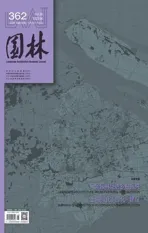风景园林助力乡村振兴
2022-06-21张浪
进入2022年3月后,上海经历了新冠疫情以来最严峻的一场考验,而且明显表现出中心城区严重于郊区;高密城区内高楼林立,大量人口群集在相对狭窄空间里,这与生态化的乡村社会是全然不同的,如此让人想起中国有句古话,“大疫止于野”。同时,乡村“十里不同风”与城市的“千城一面”截然不同,生态化的乡村是人与自然共生、空间生态资源共享的,也是危机软着陆的重要载体。4月21日仙逝的著名园林专家程绪珂先生,早在20世纪就对城市提出了“生态园林理论体系”,强调要打破“城市围墙”,坚定地走城乡绿化一体化的道路。要遵循生态学的原理,大力开展低碳、碳汇等植物群落的研究,建设多层次、多结构、多功能、科学的植物群落。以经济学为指导,强调直接经济效益和间接经济效益并重,应用系统工程来发展园林,使生态、社会和经济效益同步发展。城乡绿化一体化不是盲目地将乡村中的自然生态系统进行城市化处理,而是因地制宜,“各美其美”,守护住自然乡野之貌。
只有加速生态文明建设、推动人类文明生态转型,才能实现人与自然和谐共生的现代化。党的十八大以来,习近平总书记多次强调生态文明建设和绿色发展是关系中华民族永续发展、建设人类命运共同体的根本大计。2021年10月,中共中央办公厅、国务院办公厅印发的《关于推动城乡建设绿色发展的意见》指出,城乡建设是推动绿色发展、建设美丽中国的重要载体,美丽乡村是绿色发展的生态基底。站在“十四五”开局的新起点,立足风景园林学科,加快生态园林建设、协调统筹城乡发展、实施乡村振兴战略是推动城乡园林绿化事业高质量发展,满足人民群众对美好生活和优质生态产品需要的重要抓手。
本期分为“风景园林促进乡村振兴”和“上海绿化‘四化’建设”两个专题。其中,专题1内容涵盖(1)历史文化名村植物景观原真性保护,揭示乡村植物景观与历史文化保护之间的学理关系;(2)中国乡村景观实践发展历程(1949 - 2022年);(3)植物景观感知研究,提供了一种乡村植物景观特色塑造“落地”生效的评价与设计工具;(4)常州55个村落中275个标准样地内植物群落的植物资源科属种、生活型、物种来源组成等的调查研究,展示了乡村植物群落特征的专业观察、描述与评价方法;(5)基于多源数据构建景中村评价模型,探究了景中村景观游憩吸引力生成的规律性。专题2内容主要涵盖城市空间植物景观的评价、配置模式以及提升策略研究。两个专题展示了生态园林理论体系在城乡园林绿化中的适用共性,也体现了乡村生态主导空间和城市人工主导空间在植物景观营造、保护以及提升方面的本质差异性。
当然,乡村振兴也是中国应对全球化挑战的压舱石,如何有力有效地高质量推进,所需要研究探索的问题还很多,例如如何将资产在生态化乡村振兴中激活,实现乡村生态产品价值市场化等等。风景园林专业能解决的问题可能只是一个方面,但是我们应积极更新知识体系,运用最新的技术手段和学科间的交叉融合,一定能助力2035美丽中国建设目标的实现。让青山常在、绿水长流,形成绿色生产方式和生活方式,才能使人们望得见山、看得见水、记得住乡愁,用美丽乡村扮靓美丽中国。
主编
2022年5月3日
Landscape Architecture Promotes Rural Revitalization
Since March 2022, Shanghai has experienced a severe COVID-19. It is obvious that the central urban area is more serious than the suburbs; there are a large number of people are clustered in a relatively narrow space, which is completely different from ecological rural society. This reminds us of an old Chinese saying, “Great epidemics end in the wild”. Ecological villages are the symbiosis of man and nature, the sharing of spatial ecological resources, and an important carrier of crisis soft landing. Mr. Cheng Xuke, a famous landscape architecture expert who passed away on April 21, put forward the “Ecological landscape architecture theory system” for the city as early as the last century, emphasizing the need to break the “urban wall” and firmly take the road of integrating urban and rural greening. In addition, it is necessary to follow the principles of ecology, vigorously carry out the research on low-carbon, carbon sink and other plant communities, and build a multi-level, multi-structural, multi-functional and scientific plant communities. Under the guidance of economics, it emphasizes both direct and indirect economic benefits, and applies system engineering to develop the landscape architecture, so as to make ecological,social and economic benefits develop simultaneously. The integration of urban and rural greening is not to blindly urbanize the natural ecosystem in the countryside, but to adapt measures to local conditions and protect the appearance of natural countryside.
Only by accelerating the construction of ecological civilization and promoting the ecological transformation of human civilization can we realize the modernization of harmonious coexistence between man and nature. Since the 18th National Congress of the Communist Party of China, General Secretary Xi Jinping has repeatedly emphasized that the construction of ecological civilization and green development are the fundamental plans related to the sustainable development of the nation. In October 2021, the Opinions on Promoting Green Development of Urban and Rural Construction pointed out that urban and rural construction is an important carrier for promoting green development and building a beautiful China, and beautiful countryside is the ecological basis for green development.The 14th Five-Year Plan requires us to speed up the construction of ecological landscape architecture, coordinate urban and rural development, and implement the strategy of rural revitalization based on the discipline of landscape architecture, so as to promote the high-quality development of urban and rural landscaping and meet the needs of the people for a better life and high-quality ecological products.
This issue is divided into two topics: “Landscape Architecture Promotes Rural Revitalization” and “Shanghai Greening ‘Four Modernizations’ Construction”. Among them, topic 1 covers (1) The protection of the authenticity of plant landscapes in historical and cultural villages; (2) The development process of rural landscape practice in China (1949-2022);(3) Research on plant landscape perception; (4) Research on the characteristics of plant communities in 275 standard plots of 55 villages in Changzhou; (5) Building an evaluation model for village based on multi-source data. Topic 2 mainly covers the evaluation of urban spatial plant landscape, the configuration mode and the research on improvement strategies. The two topics show the commonalities of the application of ecological landscape architecture theory system in urban and rural landscaping, and also reflect the essential differences between rural ecologically dominated space and urban art ificial dominated space in the construction, protection and enhancement of plant landscapes.
Of course, rural revitalization is also the ballast stone for China to cope with the challenges of globalization. There are still many problems to be studied and explored on how to effectively promote rural revitalization. For example, how to activate the assets in ecological rural revitalization and realize the value market of rural ecological products. The problems that Landscape Architecture can solve may be only one aspect, but we should actively update the knowledge system, and use the latest technical means and interdisciplinary integration to help achieve the goal of building a beautiful China in 2035. Only by forming a green mode of production and lifestyle can people see the mountains and the water, remember their homesickness and dress up beautiful China with beautiful villages.
Editor-in-Chief
May 3th, 2022
